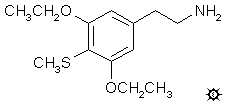
#177 4-TSB
4-THIOSYMBESCALINE; 3,5-DIETHOXY-4-METHYLTHIOPHENETHYLAMINE
|
| [3D .mol structure] |
To a stirred solution of 16.7 g of 2,6-diethoxythioanisole in 175 mL CH2Cl2 there was added 13 g elemental bromine dissolved in 100 mL CH2Cl2. After stirring at ambient temperature 1 h, the dark solution was added to 150 mL H2O containing 1 g of sodium dithionite. Shaking immediately discharged the residual bromine color, and the organic phase was separated. The aqueous phase was extracted once with 100 mL CH2Cl2, the pooled extracts washed first with H2O, and then with saturated brine. Removal of the solvent under vacuum provided 28.6 g of a pale yellow oil with several globs of H2O present. This wet product was distilled at 118-125 °C at 0.25 mm/Hg to yield 3-bromo-2,6-diethoxythioanisole as a white oil weighing 21.5 g. It could not be crystallized. Anal. (C11H15BrO2S) C,H.
To a solution of 19.3 g diisopropylamine in 75 mL hexane under a He atmosphere there was added 100 mL of 1.6 M butyllithium. The viscous mixture was loosened by the addition of 200 mL anhydrous THF, and this stirred mixture was cooled with an external ice bath. There was then added 4.0 mL of dry CH3CN, and 11.6 g of 3-bromo-2,6-diethoxythioanisole (which had been diluted with a little anhydrous THF). The deep red brown reaction mixture was stirred for 0.5 h, and then poured into 1 L dilute H2SO4. This was extracted with 3x75 mL CH2Cl2, the extracts pooled, washed with H2O, dried with anhydrous K2CO3, and the solvent was removed under vacuum. The residue was distilled at 0.3 mm/Hg yielding two fractions. The first fraction boiled at 120-140 °C and weighed 1.2 g. This fraction partially crystallized, but was not investigated further. The second fraction was 3,5-diethoxy-4-methylthiophenylacetonitrile, which came over at 135-160 °C, was a yellow liquid, weighed 3.2 g, but did not crystallize.
A solution of LAH in anhydrous THF (30 mL of a 1.0 M solution) under N2 was cooled to 0 °C and vigorously stirred. There was added, dropwise, 0.78 mL 100% H2SO4, followed by 3.0 g 3,5-diethoxy-4-methylthiophenylacetonitrile diluted with a little anhydrous THF. The reaction mixture was stirred at 0 °C for a few min, then brought to reflux on the steam bath for 1.5 h. After cooling back to room temperature, there was added IPA to destroy the excess hydride and 10% NaOH to bring the reaction to a basic pH with the conversion of aluminum oxide to a loose, white, filterable consistency. This was removed by filtration, and washed first with THF followed by IPA. The filtrate and washes were stripped of solvent under vacuum, the residue added to 1 L dilute H2SO4. This was washed with 2x75 mL CH2Cl2, made basic with 25% NaOH, and extracted with 3x100 mL CH2Cl2. After combining, the solvent was removed under vacuum providing an orange oil. This was distilled at 135-160 °C at 0.4 mm/Hg to give a light yellow oil. This was dissolved in 20 mL of IPA, and neutralized with 32 drops of concentrated HCl producing white crystals spontaneously. These were dissolved by bringing the IPA suspension to a boil on the steam bath and, with stirring, diluted with 80 mL of warm anhydrous Et2O. There was the immediate formation of crystals which were removed by filtration, washed with an IPA/Et2O mixture, and then with Et2O. After air drying there was obtained 1.5 g of 3,5-diethoxy-4-methylthiophenethylamine hydrochloride (4-TSB) as white crystals. The mp was 194.5-196 °C. Anal. (C13H22ClNO2S) C,H.
DOSAGE: greater than 240 mg.
DURATION: unknown.
QUALITATIVE COMMENTS: (with 80 mg) There was a real effect about three hours into this experiment--a little bit spacey while I was talking to Mr. X. But the talk went well, and we were all really friendly. There was no hint that he suspected anything. A couple of hours later, nothing.
(with 160 mg) Twinges at a couple of hours, but the rest of the day disappointing as to any effect from the drug.
(with 240 mg) No effects at all.
EXTENSIONS AND COMMENTARY: Here is an excellent presentation of a report that shows false positives or maybe false negatives. Something at low levels. Nothing at higher levels. Always tend to trust the absence of an effect in preference to the presence of an effect, if one of the two observations is presumed to be in error.
| [ |
[Main Index] | [Forward |

